the last professional PortaSound, with FM synthesizer, MIDI and drumpads
| YAMAHA PSS-780
the last professional PortaSound, with FM synthesizer, MIDI and drumpads |
This was Yamaha's likely most advanced approach to build a professional PortaSound keyboard; this top of the line flagship of the MusicStation series from 1989 featured MIDI, a real FM synthesizer, various sequencer stuff, a programmable drum section with 8 drum pads, 61 keys and even a pitchbend wheel. (Later successors had no synthesizer anymore.) Unfortunately it also has some annoying limitations; especially the FM synthesizer lacks many sound features those were present in cheaper Yamaha keyboards, and there is also neither a modulation wheel nor is anything velocity sensitive.
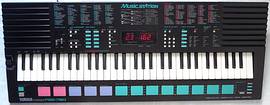 |
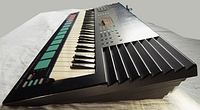 |
Almost the same keyboard was released earlier in 1988 as Yamaha PSS-680 (different case colours, all boring blue pads).
 (old eBay photo of my specimen)
(old eBay photo of my specimen) |
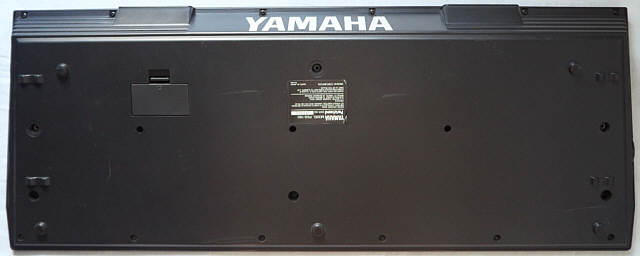 |
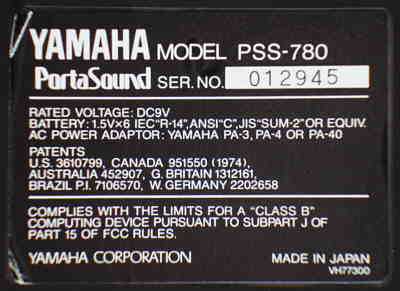 |
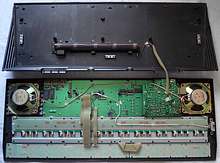 |

 |
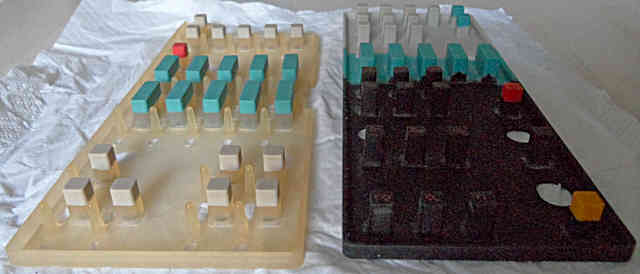
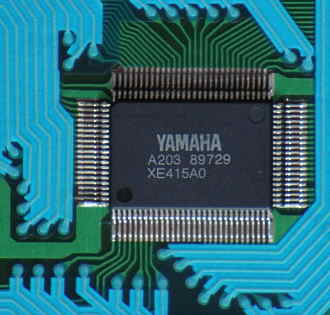 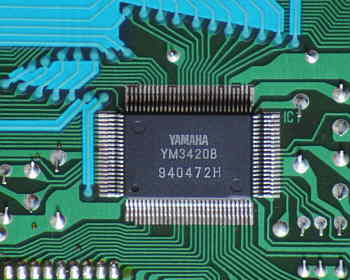 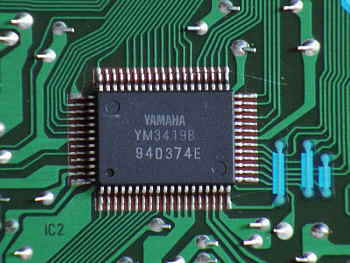 |
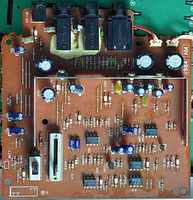 |
The preset sounds are basic 2 operator FM. Any FM sounds (preset or modified through the synthesizer) can be saved to 5 OBS user preset buttons for quick selection. The FM synthesizer has only standard 2 operator sounds, and only 8 parameters can be accessed through control panel buttons (operator 1: {attack rate, decay rate, frequency, feedback level}, operator 2: {attack rate, decay rate, frequency, total level}). The rest (e.g. various octave select and vibrato/ tremolo parameters) are only accessible through MIDI or indirectly by selecting an appropriate preset sound before modifying the accessible parameters. Unfortunately the original preset sound template can not be exchanged without loosing the current user modified parameters, despite this would make it much easier and more intuitive to compare the behaviour of different sounds by exchanging only the inaccessible internal parameters (like the PSS-390 can do) and keeping the rest..
Most parameter are changed by pressing a corresponding select button and then change the value with 2 small black "value" +/- rubber buttons, those are badly visible. (These buttons can not be used to quickly step through the 100 voice bank, which is annoying.) Due to these buttons also edit FM parameters and the main voice volume, it would be interesting to solder in a digital rotary endless controller (a knob with a mouse- like optical encoder and a few 74LS ICs for direction sensing) for this function, because this way also any of the FM parameters would become controllable in realtime during performance. (The +/- buttons react well on rapid single presses, and only switch into fast counting mode when held down longer. Pressing both +/- buttons resets the parameter to default.)
My Yamaha PSS-390 (also Fujitone 6A) uses also 4 operators for many of its sounds (i.e. quasi 2 internally layered 2 op sounds =>half polyphony but more realistic/ thicker) and has many wild noise presets with complex pitch LFO, arpeggiator and retrigger effects (e.g. ringing "mandolin", "telephone", "helicopter", "machine gun", gritty and fat "brass ensemble", arpeggios in "crystal", "comet" etc. and lots of great siren- like howling stuff like "ufo" or "ghost", even with stereo panning), which I always expected to be standard with Yamaha FM instruments. But when I bought the semi- professional Yamaha PSS-780, I disappointedly discovered that it has none of these great effects but uses only very plain 2 operator FM, nor it features any funny noise presets. By the lack of 4 operator sounds e.g. the "human voice" sounds of the PSS-780 sound extremely thin and hollow, and there is not even a ringing mandolin possible. I also downloaded manuals of other MIDI PortaSounds with FM synthesizer, and they all lack these great effects. Possibly Yamaha feared here to confuse customers with too many editable parameters, but they could have simply kept them uneditable as already some other parameters are. Possibly also the complex LFO and envelope effects would have disturbed the delicate timing of MIDI transmission because they are likely generated by the main CPU and not controlled by the sound chip itself. With the PSS-390 particularly the noise effect presets can be easily tweaked into the most fantastic and bizarre tekkno sounds, and that these of all don't exists in any MIDI PortaSounds makes it difficult to rate which PortaSound is the best. But at least the portamento and pitchbend permit to simulate some siren effects by hand.
The "reverb" effect of the PSS-780 is simply a modification of the FM sound envelope (and thus has no effect on drum samples). The portamento makes nice slide sounds (5 speeds adjustable). The "stereo chorus" effect is a sort of rotary speaker simulation, which is a simple panning effect of the rather unspectacular kind (when off, the FM sound is simply mono). In "duet" mode the instrument plays a 2nd voice (distance selected by a pressed key in accompaniment section, but by unknown reasons it is only monophonic even with sufficient free sound channels; the great old Yamaha MK-100 had no problems with this and could even play a trio despite of even less polyphony). The OBS mute buttons make accompaniment much more flexible as they provide some access to different tracks in each style (in most styles the "orchestra" button mutes the arpeggio part); unfortunately there are no separate volume control for these accompaniment tracks. I also really miss here a "dual voice" mode to layer multiple sounds; the PSS-390 could sound really fat by layering 2 voices and the old MK-100 could even layer up to 3 voices. In spite of this the PSS-780 has a reasonable sounding standard piano with a more realistic bass section than the default piano of the PSS-390. Also the sitar sounds great.
The percussion samples are besides 3 synth toms all plain acoustic drum kit stuff (no tekkno base drums). All percussion have each a fixed stereo position and no editable parameters. When "synchro break" button is pressed, the drumpads mute a playing rhythm for the duration of a measure to permit live drum solo fill-ins (otherwise they play percussion simultaneously with the rhythm). The custom drummer can be abused in a limited way as a realtime drum computer, because in programming mode while a pattern is repeating, percussion can be added by drumpads (with drumroll or with accent = twice loud) and either a single percussion sound or all entered sounds can be deleted by a key press. But no keyboard notes can be played in this mode, because the keys are muted and partly used for OBS {clear, accent, drumroll, all clear} functions instead. The length of the drum pattern depends on the selected style.
The 5 melody memory sequencer banks are only monophonic, but can store in the pattern pitchbends, some effect settings and current voice numbers. Multiple banks are combinable during record for polyphonic recording. Multiple banks can also be started to playback their sequences - even while recording another. The 5 chord memory banks can store chord changes, fill-ins, tempo setting etc. (synchronized with the accompaniment), and they can even start playback of melody memory banks, but they can not be used to program own accompaniment styles. There are also absolutely no edit nor copy nor "one key play" features available for the sequencers.
The value of the accompaniment section of the PSS-780 is a rather questionable and difficult to rate things. At the one hand there are 100 very richly and wonderfully orchestrated styles available with each 3 fill- ins and an ending, and they can be very inspiring and a lot of fun to improvise to and play around with. At the other hand (like with all later PortaSound keyboards) the accompaniment reacts only strictly on what some snobbish establishment music academics have defined to be "chords", i.e. even in "fingered chord" mode you can not force the accompaniment to play any other notes or note combinations, because this stubborn final automaton simply completely ignores any other key combination and behaves like when no accompaniment keys were pressed at all (i.e. it continues playing the previous chord). I conclude that this style bank algorithm recognizes chords and then transposes out of a hand full of pre- written note sequences a corresponding one for each known chord from its ROM library to play it. This should possibly enable it to add some small "human touch" fill- ins with certain chord changes, but when no known chords are played, this stubborn silly thing is totally blind and can do nothing. A reasonable accompaniment algorithm should instead count the number of pressed keys in the accompaniment section and simply play the notes of these keys at the correct time, no matter which keys they are and whether their notes form a chord or not. Casio could do this already in its very first automatic accompaniments, old Yamaha keyboards did this too, and my Testron keyboard is a good example how versatile such a plain accompaniment algorithm can sound. Even my Fujitone 6A is clever enough to play non- chords and single notes by its automatic accompaniment. But with this stupid modern Yamaha style bank you can only play always chord with the full number of notes, and this is particular annoying since the 100 preset styles are (although nice) quite over- orchestrated and over- specialized; most of them are black music (jazz, blues, funk, reggae etc.) or classical music, and also the rest has strong tendencies to sound this way. Can you imagine, there is e.g. no plain waltz or tango - there is just a baroque waltz, a jazz waltz and 2 tangos with both a chinking Venetian mandolin or marimba arpeggio in the background. I have nothing really against them - all these styles are cute, but they are in no way versatile, and you can not even omit some notes by pressing less or no keys. Fortunately at this instrument you can at least mute the "orchestra" part of each style to get rid of unwanted over- orchestration, which makes the styles less stubborn than on my PSS-390. Even bizarre styles like "street organ" or "circus band" suddenly become interesting candidates for tekkno trance musics when treated with the OBS mute buttons. When rhythm is stopped, the accompaniment section plays continuous chord and/ or bass tones with a timbre corresponding to the selected style. But another annoying flaw is that any notes played through the accompaniment section (i.e. also manual bass) stay always within the same octave, no matter if you press keys in the lowest or 2nd lowest keyboard octave to play them. This makes it impossible to play very low and higher bass notes (or chords) like a real key split mode should do.
I really can't understand why, but unfortunately soon after the PSS-51 Yamaha stopped making professional PortaSound instruments entirely; only cheap toy and beginners keyboards without MIDI were kept on the market under this brand name, and Yamaha also never made velocity sensitive ones. Nowadays they make no PortaSounds at all anymore. Apparently most people thought or were flavour- potentiated to think that fullsize keys mean "professionality", but in fact they just waste space and make playing more awkward since they prevent to play notes in different octaves with the same hand. Piano keys were not invented to be so big for ergonomical reasons but simply because the clumsy wooden mechanism inside a piano defined this size. Even hall- filling church organs of former centuries had often narrower and shorter keys than a modern piano, and if you ever have seen a virtuous button accordion player rushing over the tiny, typewriter sized keys of this instrument and jumping between octaves with more enormous speed than the best boogie pianist can do, it can be easily seen that fullsize keys are basically nothing but an outdated relic of snobbish establishment music academy's shiny and noble grand piano image. Unlike 1980th, nowadays only few companies still dare to bring out new professional instruments with smaller than fullsize keys, despite I would clearly prefer a velocity sensitive 88 mini (toy size) keys instrument against a 37 key fullsize one of the same case size, and likely also against any huge 88 keys fullsize one.
Fortunately at least the Yamaha PSS-780/ PSS-680 keyboards are not really rare and relatively easy to find a eBay (about 40..60€; the boring AWM successors once were even cheaper, but now have turned that expensive too).
A smaller version of the Yamaha MusicStation PSS-780 was the PSS-480/ PSS-580, which had only 49 keys and neither pitchbend wheel nor drum pads. But otherwise they seem to be technically extremely similar. The PSS-680 is almost identical with PSS-780, but have preset sound numbers in different order (I read the manual) and also the demo was changed. A sort of predecessor of the MusicStation series was the wonderful Yamaha MK-100, which although it had neither FM nor MIDI, was a much more versatile concept since it had besides synthesizer and sequencer a "custom bassist" feature with that you could program almost completely own styles, and also any of its preset rhythms could be fully re-programmed using its "custom drummer".
Successor of the PSS-780 was the
PSS-790/
PSS-795, but
these instruments from 1990 lack the great FM synthesizer (I read the manual)
and were instead just plain ordinary modern preset MIDI tablehooters based
on medium resolution samples ("AWM voices"). There is a so-called "vector
synthesizer" built-in, but this is rather a camouflage name for a simple
analogue joystick with that up to 4 selectable preset sounds can be crossfaded
in realtime. Although this is a nice feature (and usable through MIDI)
- a digital synthesizer is something different. The PSS-790 had 50 percussion
samples and adjustable vibrato, reverb and individual channel volume control,
but it had also only 50 styles, 100 fairly establishment preset sounds
and a fairly standard case design (with round speakers), and strange is
that with many of its preset sounds vibrato or reverb is disabled and can
not be used. Successor of the PSS-790 was the Yamaha PSS-51 from
1992, which had a different 100 preset sound set, 80 preset rhythms and
many sound effect samples (animal voices, vehicle noises etc.), but an
even more boring case with rectangular speakers. To learn more about these
instruments, download their manuals at Yamaha.
| removal of these screws voids warranty... | ||
 |
||
|
|